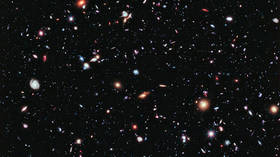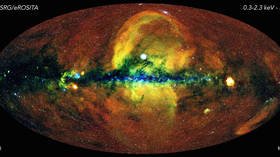Origins unknown: First rhythmic radio signals detected from 500 million light years away

A team of astronomers has picked up strange periodic signals from an unknown source outside of our galaxy for the first time ever.
The discovery of new fast radio burst (FRBs), made by the Canadian Hydrogen Intensity Mapping Experiment Fast Radio Burst (CHIME/FRB) Collaboration, was detailed in a report released in Nature magazine on Wednesday.
FRBs are short flashes of radio waves thought to be birthed from intensely dense objects. They’re the subject of much debate in the astrophysics community. Although already shrouded in mystery, what makes these FRBs, dubbed FRB 180916.J0158+65, so special is that they are the first to have produced a periodic pattern.
In the past, since they were first observed in 2007, FRB detections have had no discernible pattern and have more often been one-off events. In contrast, FRB 180916.J0158+65’s cyclical pattern stretches over a 16-day period. The pattern begins with a noisy four-day period in which FRBs are emitted from the unknown source. This is followed by a 12-day period of radio silence, before the cycle starts over again.
“This FRB we’re reporting now is like clockwork,”says Kiyoshi Masui, assistant professor of physics at the Massachusetts Institute of Technology’s Kavli Institute for Astrophysics and Space Research.
Masui is a part of the CHIME/FRB collaboration – a group of more than 50 scientists led by the University of British Columbia, McGill University, University of Toronto, and the National Research Council of Canada that analyses data from CHIME, the radio telescope that first picked up the cyclical FRB signals.
From September 2018 to February 2020, CHIME picked out 38 fast radio bursts from FRB 180916.J0158+65, leading to the discovery of the new phenomenon in astrophysics.
One possible cause of the signals raised in the paper is that it may be coming from a neutron star that is both spinning and wobbling. In astrophysics, this phenomenon is known as a precession, and refers to any of several gravity-induced, slow and continuous changes in an astronomical body’s rotational or orbital path.
Another theory is that the source is a binary system in which celestial beings such as a neutron star or black hole orbit one another, with the tides between the two objects being enough to cause a brief burst of radio waves when they swing away from one another. The orbital theory would help explain the cyclical nature of the FRBs.
Also on rt.com Astronomers spot youngest ever ‘baby’ dead starAnd then there’s a third scenario, wherein an orbiting wind or cloud of gas acts as a ‘lens’ that magnifies the source’s radio emissions. In this instance, it would mean that the source is forever omitting the FRBs, but we are only privy to them once they are amplified through this gas.
In any case, Masui adds that, “It’s the most definitive pattern we’ve seen from one of these sources. And it's a big clue that we can use to start hunting down the physics of what’s causing these bright flashes, which nobody really understands.”
Think your friends would be interested? Share this story!














